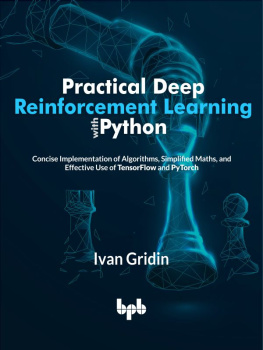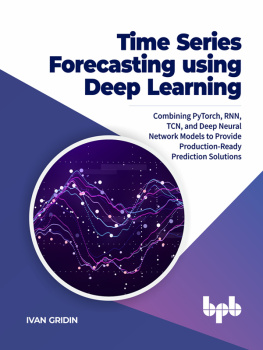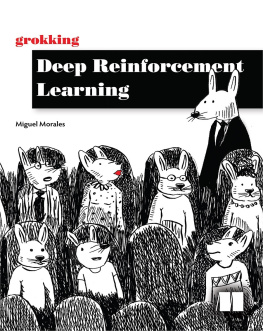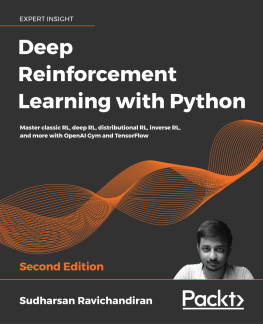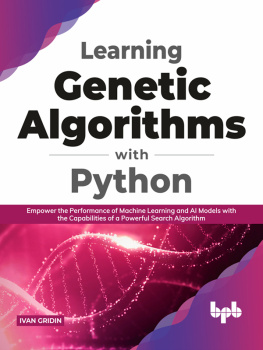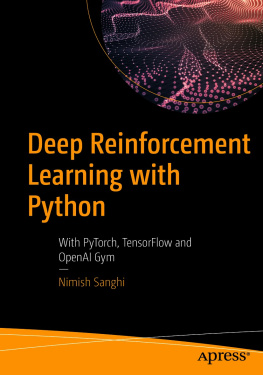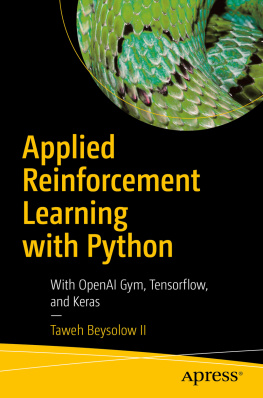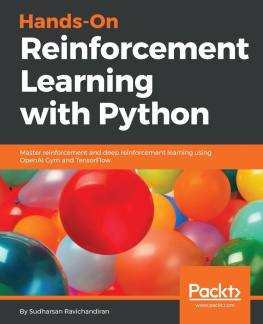Gridin Ivan - Practical Deep Reinforcement Learning with Python
Here you can read online Gridin Ivan - Practical Deep Reinforcement Learning with Python full text of the book (entire story) in english for free. Download pdf and epub, get meaning, cover and reviews about this ebook. year: 2022, publisher: BPB Publications, genre: Romance novel. Description of the work, (preface) as well as reviews are available. Best literature library LitArk.com created for fans of good reading and offers a wide selection of genres:
Romance novel
Science fiction
Adventure
Detective
Science
History
Home and family
Prose
Art
Politics
Computer
Non-fiction
Religion
Business
Children
Humor
Choose a favorite category and find really read worthwhile books. Enjoy immersion in the world of imagination, feel the emotions of the characters or learn something new for yourself, make an fascinating discovery.
- Book:Practical Deep Reinforcement Learning with Python
- Author:
- Publisher:BPB Publications
- Genre:
- Year:2022
- Rating:5 / 5
- Favourites:Add to favourites
- Your mark:
- 100
- 1
- 2
- 3
- 4
- 5
Practical Deep Reinforcement Learning with Python: summary, description and annotation
We offer to read an annotation, description, summary or preface (depends on what the author of the book "Practical Deep Reinforcement Learning with Python" wrote himself). If you haven't found the necessary information about the book — write in the comments, we will try to find it.
Gridin Ivan: author's other books
Who wrote Practical Deep Reinforcement Learning with Python? Find out the surname, the name of the author of the book and a list of all author's works by series.
Practical Deep Reinforcement Learning with Python — read online for free the complete book (whole text) full work
Below is the text of the book, divided by pages. System saving the place of the last page read, allows you to conveniently read the book "Practical Deep Reinforcement Learning with Python" online for free, without having to search again every time where you left off. Put a bookmark, and you can go to the page where you finished reading at any time.
Font size:
Interval:
Bookmark:

Deep Reinforcement
Learning with
Python

Maths, and Effective Use of TensorFlow and PyTorch

 www.bpbonline.com Copyright 2022 BPB Online All rights reserved. No part of this book may be reproduced, stored in a retrieval system, or transmitted in any form or by any means, without the prior written permission of the publisher, except in the case of brief quotations embedded in critical articles or reviews. Every effort has been made in the preparation of this book to ensure the accuracy of the information presented. However, the information contained in this book is sold without warranty, either express or implied. Neither the author, nor BPB Online or its dealers and distributors, will be held liable for any damages caused or alleged to have been caused directly or indirectly by this book. BPB Online has endeavored to provide trademark information about all of the companies and products mentioned in this book by the appropriate use of capitals. Group Product Manager: Marianne Conor Publishing Product Manager: Eva Brawn Senior Editor: Connell Content Development Editor: Melissa Monroe Technical Editor: Anne Stokes Copy Editor: Joe Austin Language Support Editor: Justin Baldwin Project Coordinator: Tyler Horan Proofreader: Khloe Styles Indexer: V. Group Product Manager: Marianne Conor Publishing Product Manager: Eva Brawn Senior Editor: Connell Content Development Editor: Melissa Monroe Technical Editor: Anne Stokes Copy Editor: Joe Austin Language Support Editor: Justin Baldwin Project Coordinator: Tyler Horan Proofreader: Khloe Styles Indexer: V.
www.bpbonline.com Copyright 2022 BPB Online All rights reserved. No part of this book may be reproduced, stored in a retrieval system, or transmitted in any form or by any means, without the prior written permission of the publisher, except in the case of brief quotations embedded in critical articles or reviews. Every effort has been made in the preparation of this book to ensure the accuracy of the information presented. However, the information contained in this book is sold without warranty, either express or implied. Neither the author, nor BPB Online or its dealers and distributors, will be held liable for any damages caused or alleged to have been caused directly or indirectly by this book. BPB Online has endeavored to provide trademark information about all of the companies and products mentioned in this book by the appropriate use of capitals. Group Product Manager: Marianne Conor Publishing Product Manager: Eva Brawn Senior Editor: Connell Content Development Editor: Melissa Monroe Technical Editor: Anne Stokes Copy Editor: Joe Austin Language Support Editor: Justin Baldwin Project Coordinator: Tyler Horan Proofreader: Khloe Styles Indexer: V. Group Product Manager: Marianne Conor Publishing Product Manager: Eva Brawn Senior Editor: Connell Content Development Editor: Melissa Monroe Technical Editor: Anne Stokes Copy Editor: Joe Austin Language Support Editor: Justin Baldwin Project Coordinator: Tyler Horan Proofreader: Khloe Styles Indexer: V. Krishnamurthy Production Designer: Malcolm D'Souza Marketing Coordinator: Kristen Kramer First published: August 2022 Published by BPB Online WeWork, 119 Marylebone Road London NW1 5PU UK | UAE | INDIA | SINGAPORE ISBN 978-93-55512-055 www.bpbonline.com
for her patience teaching me to play chess
He has worked on many projects that involve complex machine learning and deep learning algorithms and used a variety of data sets from different domains. In his career, he has successfully delivered many machine learning and deep learning solutions for complex data problems. You can find more professional details about Satyajeet on LinkedIn. (https://www.linkedin.com/in/satyajeet-dhawale/)
And my little daughter Elena for waking me up earlier you're my energizer! Thanks to my friends, who helped me in all my efforts. I want especially to thank Pavel Rogov for his valuable help when I started to make the first steps in programming. To Petr Rostov for his help in learning programming and mathematics. To Qamar Saitovski for his valuable English speech lessons. To Anatoliy Yalovik for his assistance in difficult life situations. Warm hug to Daria Kutsar.
To my good old friend Julia Vaisman for helping me to relocate to another place. This book would be impossible without all of them. My gratitude also goes to the book reviewer Satyajeet Dhawale. His participation and helpful advice have made this book much better. Special thanks to BPB Publications for their support, advice, and assistance in creating and publishing this book.
It studies how an agent can adapt and learn perfect behavior in an unknown and constantly changing environment. Many scientists consider that reinforcement learning will take us closer to reaching artificial intelligence. In the past few years, reinforcement learning has evolved rapidly and has been used in complex applications ranging from stock trading to self-driving cars. The main reason for this growth is the involvement of deep reinforcement learning, which is a combination of deep learning and reinforcement learning. Despite its popularity, reinforcement learning can seem like a rather complex area to study for a novice data scientist. Usually, many sources are overloaded with complicated mathematical concepts, proofs, and formulas.
This book provides a practical introduction to reinforcement learning. Of course, the book contains math, but it doesn't try to overwhelm the reader, who is new to the topic. Each chapter is dedicated to a specific project, which is solved using a particular approach. So the book brings an exciting journey from the origins of reinforcement learning to the most advanced deep reinforcement learning methods using PyTorch and TensorFlow. This book is divided into 2 parts. The first part introduces classical reinforcement learning.
It covers the basics of reinforcement learning, explaining famous techniques like Q-learning, the Monte-Carlo method, and Thompson Sampling. The second part is dedicated to an advanced approach called deep reinforcement learning. It demonstrates how new achievements in neural networks and deep learning can help solve common real-life problems using Deep Q-Network, Double Deep Q-Network, Policy Gradient, and Actor-Critic methods. makes a short introduction to reinforcement learning. We will study the basics of reinforcement learning. Also, we will examine how reinforcement learning differs from other machine learning approaches.
Font size:
Interval:
Bookmark:
Similar books «Practical Deep Reinforcement Learning with Python»
Look at similar books to Practical Deep Reinforcement Learning with Python. We have selected literature similar in name and meaning in the hope of providing readers with more options to find new, interesting, not yet read works.
Discussion, reviews of the book Practical Deep Reinforcement Learning with Python and just readers' own opinions. Leave your comments, write what you think about the work, its meaning or the main characters. Specify what exactly you liked and what you didn't like, and why you think so.

